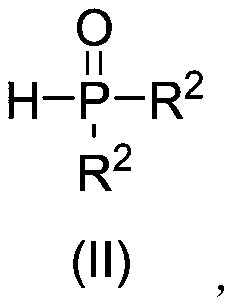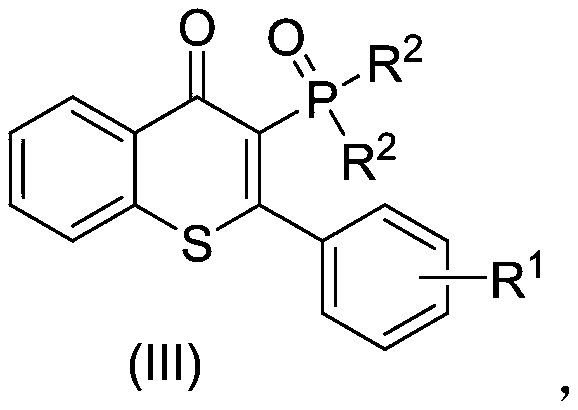Preparation method of 2-phosphonothioflavone compound
A technology of phosphonothioflavones and compounds, which is applied in the field of aqueous phase photocatalytic preparation of 2-phosphonothioflavones, can solve problems such as high reaction temperature, achieve great application value, and achieve the effect of rapid and efficient construction
- Summary
- Abstract
- Description
- Claims
- Application Information
AI Technical Summary
Problems solved by technology
Method used
Image
Examples
Embodiment 1
[0024] The preparation method of phosphonothioflavone compound 1, the steps are as follows:
[0025] In a 10mL reaction flask, add 2-methylthiophenylpropynone (0.2mmol), diphenylphosphine oxide (0.4mmol), lauryl peroxide (2.0 equivalents), tetracarbazole-dibenzonitrile (5mol %), then 2.5mL water was added to the reaction system, the reaction bottle was sealed after feeding nitrogen, and stirred at room temperature for 24 hours under the irradiation of a white light-emitting diode, until 2-methylthiophenylpropynylketone was completely converted, and The reaction solution was extracted with ethyl acetate (3×5 mL), the organic phases were combined, and dried over anhydrous and sodium sulfate, and the organic solvent was spun off. The crude product was purified by silica gel column chromatography to obtain 2-phosphonothioflavone product 1.
[0026] The specific results are as follows:
[0027]
[0028] 1 H NMR (400MHz, Chloroform-d) δ8.23 (dd, J=8.1, 1.1Hz, 1H), 7.78-7.72(m, ...
Embodiment 2
[0030] The preparation method of phosphonothioflavone compound 2, the steps are as follows:
[0031] Add 2-methylthiophenylpropynone (0.2mmol), diphenylphosphine oxide (0.4mmol), lauryl peroxide (2.0 equivalents), and tetracarbazole m-dibenzonitrile (5mol) in a 10mL reaction flask. %), then 2.5mL water was added to the reaction system, the reaction bottle was sealed after feeding nitrogen, and stirred at room temperature for 24 hours under the irradiation of a white light-emitting diode, until 2-methylthiophenylpropynylketone was completely converted, and The reaction solution was extracted with ethyl acetate (3×5 mL), the organic phases were combined, and dried over anhydrous and sodium sulfate, and the organic solvent was spun off. The crude product was purified by silica gel column chromatography to obtain 2-phosphonothioflavone product 2.
[0032] The specific results are as follows:
[0033]
[0034] 1 H NMR (400MHz, Chloroform-d) δ8.23 (dd, J = 8.1, 1.4Hz, 1H), 7.81...
Embodiment 3
[0036] The preparation method of phosphonothioflavone compound 3, the steps are as follows:
[0037] In a 10mL reaction flask, add 2-methylthiophenylpropynone (0.2mmol), diphenylphosphine oxide (0.4mmol), lauryl peroxide (2.0 equivalents), tetracarbazole-dibenzonitrile (5mol %), then 2.5mL water was added to the reaction system, the reaction bottle was sealed after feeding nitrogen, and stirred at room temperature for 24 hours under the irradiation of a white light-emitting diode, until 2-methylthiophenylpropynone was completely converted, and The reaction solution was extracted with ethyl acetate (3×5 mL), the organic phases were combined, and dried over anhydrous and sodium sulfate, and the organic solvent was spun off. The crude product was purified by silica gel column chromatography to obtain 2-phosphonothioflavone product 3.
[0038] The specific results are as follows:
[0039]
[0040] 1 H NMR (400MHz, Chloroform-d) δ8.21 (dd, J = 8.1, 1.3Hz, 1H), 7.77-7.72 (m, 4H...
PUM
 Login to View More
Login to View More Abstract
Description
Claims
Application Information
 Login to View More
Login to View More - R&D
- Intellectual Property
- Life Sciences
- Materials
- Tech Scout
- Unparalleled Data Quality
- Higher Quality Content
- 60% Fewer Hallucinations
Browse by: Latest US Patents, China's latest patents, Technical Efficacy Thesaurus, Application Domain, Technology Topic, Popular Technical Reports.
© 2025 PatSnap. All rights reserved.Legal|Privacy policy|Modern Slavery Act Transparency Statement|Sitemap|About US| Contact US: help@patsnap.com



